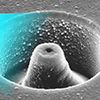| Jan 13, 2023 |
|
(Nanowerk News) Proteins are naturally fluorescent in the ultraviolet, offering an appealing approach to probe proteins in their native state without introducing any external fluorescent label. The UV autofluorescence of proteins is based on the presence of tryptophan amino acids, which typically occur as 1 to 5 tryptophan per protein.
|
|
However, due to weak signals and large backgrounds in the UV, the current technology was restricted to large proteins featuring several tens of tryptophan residues. The vast majority of proteins remained well below the detection sensitivity for single label-free protein detection.
|
|
In a recent Nano Letters publication (“Ultraviolet Nanophotonics Enables Autofluorescence Correlation Spectroscopy on Label-Free Proteins with a Single Tryptophan”), our team breaks into this sensitivity limit and achieves label-free UV-autofluorescence detection down to the single tryptophan level thanks to a nanophotonic enhancement of the signal.
|
 |
| Researchers push the sensitivity of label-free ultraviolet fluorescence correlation spectroscopy (UV-FCS) down to the single tryptophan level. (© Nano Letters)
|
|
Our approach relies on a rationally-designed combination of plasmonic antennas, antioxidants and background noise reduction techniques to improve the signal to background ratio by over an order of magnitude. Achieving the ultimate sensitivity of UV-FCS down to the single tryptophan regime has wide applications for various communities from nanophotonics to biochemistry.
|
|
We conclusively demonstrate UV-fluorescence correlation spectroscopy (UV-FCS) on proteins with a single tryptophan residue. This unlocks the applicability of UV-FCS to a broad library of thousands of proteins, which remained previously inaccessible (over 90% of human proteins have at least one tryptophan residue, but only 4% have more than 20 tryptophans). Fluorescence correlation spectroscopy (FCS) and related techniques have a large impact on molecular biophysics in assessing diffusion properties, local concentrations or kinetic reaction rates.
|
|
The signal to background maximization approach is of interest to a wide range of scientists and engineers working with single molecule fluorescence, photonics, or plasmonics. Our article details several multidisciplinary aspects: (i) plasmonic nanophotonic elements to enhance the fluorescence, (ii) antioxidants to neutralize the reactive oxygen species ubiquitous to ultraviolet and (iii) background suppression based on a rational understanding of the background physical origins.
|


